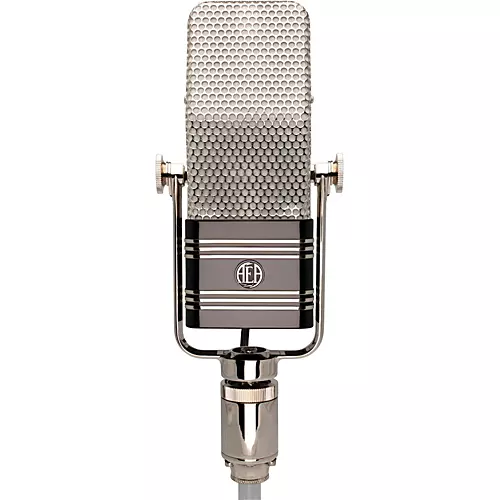AEA Microphones R44C Bidirectional Big Ribbon Studio Microphone
Quantity
-
DetailRCA 44 ribbon microphones have remained an essential part of studio life well after RCA stopped manufacturing them in 1955. The sound and response of the 44 B/BX were unlike anything else available,and was cherished for its smoothness, forgiving nature and unique tonal balance. As collectors began to buy up the supply of RCA 44s through the 90s, the availability of this wonderful ribbon mic to the studio was greatly endangered. Wes Dooley, a specialist in ribbon mics of all kinds, recently began a project to restore availability of the RCA 44 to its rightful position in the studio. After tracking down the folks who built and designed the original RCA 44, Wes�?company, Audio Engineering Associates, acquired the ribbon material, made the tooling and custom machined the parts necessary to build the original RCA 44 B/BX design as it was in the 1930s. After years of painstaking work, AEA has again begun production of the most important ribbon mic of all time: the AEA R44C.How is the R44 different from other ribbon microphones?The 44 was RCA’s best microphone from the 1930s into the �?0s. Is AEA’s R44 that good? Both listeners and measurements say that the R44 is better. Why would that be? Using original ribbon material with modern high-strength magnets helps. Com- bining the original American undamped ribbon design with British RCA 44 innovations that lower the weight and hum sensitivity contributes to further improvement. Listening to comments from both users and ex-RCA engineers for over 20 years has also had a lot to do with how good AEA’s R44 has become.The R44 design runs contrary to all current ribbon microphone manufacturing. It is large and heavy when other microphones are smaller and lighter. The internal ribbon element is by far the longest and its resonance tuning the lowest of today’s rib- bon microphones. It is a pure undamped ribbon design, an approach that has been out of production for over 50 years while remaining in continuous studio use. It is different, and its sound is unique.The R44 sounds good on everything. Leave it out and use it whenever you need to do a quick take. Everyone has a favorite use and everyone finds they sound good anywhere: brass, woodwinds, percussion, strings or voice work.AEA developed a modified R44 transducer, called the X-Motor, that includes two additional magnets that provide an extra 6db of output. With a sound identical to the original 44, the X-Motor ‘hot rod�?mod is useful for scoring and classical sessions and other applications demanding a wide dynamic range with the classic 44 sound. Available as an upgrade in R44C and CE models, the X-Motor version of the R44 bears a red-badge on the outside instead of the standard black badge.
-
Customer ReviewsNo comments

 Fender
Fender Gibson
Gibson Taylor
Taylor Martin
Martin lbanez
lbanez Epiphone
Epiphone PRS
PRS Schecter Guitar Research
Schecter Guitar Research Fender Stratocaster
Fender Stratocaster Fender Telecaster
Fender Telecaster Gibson Les Paul
Gibson Les Paul Gibson SG
Gibson SG lbanez RG
lbanez RG Taylor American Dream
Taylor American Dream Taylor GS Mini
Taylor GS Mini Martin GPC
Martin GPC lbanez
lbanez Fender
Fender Squier
Squier Ernie Ball Music Man
Ernie Ball Music Man Sterling by Music Man
Sterling by Music Man Rickenbacker
Rickenbacker Sire
Sire Schecter Guitar Research
Schecter Guitar Research Fender Precision Bass
Fender Precision Bass Fender Jazz Bass
Fender Jazz Bass Fender Mustang
Fender Mustang lbanez SR
lbanez SR Strandberg Boden
Strandberg Boden Yamaha TRBX
Yamaha TRBX Yamaha BB
Yamaha BB Schecter Stiletto
Schecter Stiletto Fender
Fender Marshall
Marshall Orange Amplifiers
Orange Amplifiers Markbass
Markbass Boss
Boss Blackstar
Blackstar Kemper
Kemper Vox
Vox Line 6
Line 6 Electro-Harmonix
Electro-Harmonix MXR
MXR Meris
Meris Dunlop
Dunlop EarthQuaker Devices
EarthQuaker Devices lbanez
lbanez TC Electronic
TC Electronic Alesis
Alesis Roland
Roland Zildjian
Zildjian DW
DW Simmons
Simmons Meinl
Meinl Remo
Remo TAMA
TAMA Pearl
Pearl Vic Firth
Vic Firth Sound Percussion Labs
Sound Percussion Labs Evans
Evans Sabian
Sabian Lp
Lp Yamaha
Yamaha Yamaha
Yamaha Roland
Roland Korg
Korg Williams
Williams Akai Professiona
Akai Professiona Casio
Casio Nord
Nord Moog
Moog Williams Legato
Williams Legato Yamaha Clavinova
Yamaha Clavinova Harbinger
Harbinger Bose
Bose JBL
JBL Electro-Voice
Electro-Voice Behringer
Behringer Yamaha
Yamaha Mackie
Mackie JBL EON
JBL EON Bose L1 Pro
Bose L1 Pro QSC K Series
QSC K Series Yamaha Mixers
Yamaha Mixers Harbinger VAR!
Harbinger VAR! Focusrite
Focusrite Universal Audio
Universal Audio Yamaha
Yamaha PreSonus
PreSonus Tascam
Tascam KRK
KRK Rode
Rode Focusrite Scarlett
Focusrite Scarlett Universal Audio Apollo
Universal Audio Apollo Shure
Shure Sennheiser
Sennheiser AKG
AKG Neumann
Neumann Rode
Rode Sterling Audio
Sterling Audio Audio-Technica
Audio-Technica Warm Audio
Warm Audio AKG 414
AKG 414 Musician Geal
Musician Geal Fender
Fender D'Addario
D'Addario Ernie Ball
Ernie Ball Elixir
Elixir Road Runner
Road Runner Gator
Gator Proline
Proline Remo
Remo Livewire
Livewire On-Stage
On-Stage Hercules
Hercules Mogami
Mogami Dunlop
Dunlop Perri's
Perri's Snark
Snark

